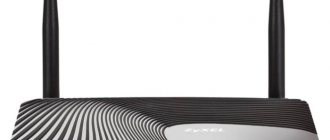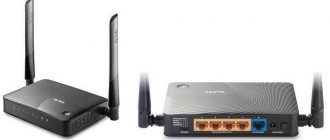The latest generation Zyxel Keenetic 4G routers are distinguished by increased network coverage due to a powerful antenna and maximum throughput, which in theory reaches 300 Mbit/s. They support all existing network types and work with all providers. It is advisable to use such a device for distributing 3G/4G Internet in a private home, small office or enterprise. The device can also be used as a regular router. Let's take a closer look at how to configure the Zyxel Keenetic 4G III router.
Ease of connection
For a video review and instructions on setting up the Zyxel Keenetic 4G III router, see the following video:
The device comes with a USB extension cable that allows you to place the access point in a convenient place - one end of the cord is connected to the router, the other to the modem (at this end there is a suction cup for attaching the cable with the modem to the glass).
To connect, you need to turn on the power supply and connect it to the device, connect the modem via a USB port located on the back panel of the router or through a special extension cord. When using wired Internet, we insert the network cable entering the house or apartment into the WAN port. We connect the Internet station to a computer or laptop for configuration via LAN.
After loading the device, a Wi-Fi access point will appear, which anyone can join. The settings of the Zyxel Keenetic 4G III router are protected by a simple password; it is better to change it to something reliable.
Characteristics
KN-1211 is the most affordable model in the Keenetic line with support for 3G/4G modems. In fact, this is the Keenetic Start KN-1110, well known to fans of the brand, into which a USB port is soldered. They look exactly the same: a compact white body, a laconic design and two non-removable antennas on the sides.
Inside is a 575 megahertz processor and 64 megabytes of RAM. For a budget router the set is quite standard.
There are four network ports. One of them can be used as a WAN to connect to the Internet via cable. Speed – 100 Mbit/sec.
Wi-Fi class – N300. The wireless network accelerates to 300 Mbps. The antenna gain is 5 dBi. Wi-Fi range is 2.4 GHz.
You can connect a printer, flash drive or 4G modem to the USB 2.0 port. The list of supported modems for Keenetic 4G KN 1211 includes more than 150 models.
Comparison of the main characteristics of Keenetic 4G KN-1210 and KN-1211:
This model differs from its updated brother Keenetic 4G KN-1211 only in the amount of built-in flash memory. The 1210 has 16 megabytes, and the 1211 has 32 megabytes.
The memory uses Dual Image technology. That is, the firmware is duplicated. And if suddenly, as a result of a failure or unsuccessful user movements, the router software crashes, a working copy of it will be loaded.
As for the software, it is universal for all Keenetic routers. The operating system capabilities of the 1211 are exactly the same as those of expensive models. They are limited only by the hardware of the device.
User reviews of the Keenetic 4G router are positive. Most are pleased with the purchase.
Compact design
Stable work
Easy setup
Fixed antennas
3 LAN ports
Indicators and buttons
On the front panel of the router there is a Wi-Fi button and three indicators.
The main purpose of the button is to activate the WPS mode and turn on/off wireless network broadcasting. A single short press will launch the WPS function. You can quickly connect other devices to your router without entering a password. Long press for at least 3 seconds to turn Wi-Fi off or on. In the settings, you can set other functions for the button. For example, turning off the LEDs on the case or activating a guest network. Up to three actions – short, double and long press.
Indicators from left to right have this purpose.
- “Status” (with the power icon) is constantly lit when the router is turned on. Slow flashing means the device is booting/rebooting or a firmware update is in progress. Flashing quickly for two seconds indicates that the function assigned to the Wi-Fi button has been activated.
- “Internet” (globe image) informs about the status of the network connection. On - the Internet is connected, off - there is no Internet.
- The Wi-Fi indicator does not light up if the wireless network is disabled. Lights up or blinks quickly – the network is on, data is being exchanged. The indicator blinks slowly to indicate that WPS mode is activated and devices are being connected.
Preparation
For normal functioning of the network, you should select automatic distribution of IP and DNS servers. This is done as follows.
- Open “Network Settings...” through the context menu of the network tray icon.
- Call up the window for changing adapter settings, then open its properties through the context menu.
- Click on the line responsible for changing the parameters of the fourth edition protocol, and set the automatic method for obtaining DNS and IP.
- Save the new configuration.
Setting up Wi-Fi (how to change the password)
Everything is quite easy to set up:
- We go to the fourth section on the panel below (indicated by a ladder - this is the “Wi-Fi” icon).
- At the access point, select the WPA2 PSK security type and boldly write a new network key - this is the password.
- Set the country to Russian Federation. Everything else can be left unchanged for now. Click on “Apply”. Now, using the set password, you can log into your Wi-Fi network.
Write a complex password in the key
Connection
Everything is very simple here.
- We connect a LAN cable, crimped at both ends, between the router and the computer or laptop through which the device will be configured.
- We turn on the power supply to the network by plugging its other end into the corresponding connector on the back panel of the wireless access point.
- We connect the modem directly or through an extension adapter, or WAN, if you will be distributing the Internet received via cable.
WiFi router Zyxel Keenetic 4G as a router in a home network
After the Internet, you need to configure the local network - both wired and wireless - we remember that the router has 4 LAN inputs, which means it can work as a regular router and supply the Internet to computers using regular patch cords.
Here you need to do everything as in the screenshot - assign a range of IP addresses, set the IP for the router itself in Server mode. If necessary, you can manually assign a specific address to a specific device based on its MAC ID.
Configuration
Configuring the Zyxel Keenetic 4G 3 router to suit your needs and connecting it is carried out in two ways:
- through the “Configuration Wizard” (automatic);
- via the web interface (manual).
Automatic
For novice users, a semi-automatic mode is provided, which allows you to configure the Kinetic 4G router in a step-by-step mode, just by answering the wizard’s questions.
- To open the page where the Zyxel Keenetic 4G is configured, launch the Internet browser.
- In its address bar we write 192.168.1.1 or my.keenetic.net (look for information on the sticker on the bottom of the case).
- Enter your login information, usually “admin” in both fields.
- We immediately enter new data to protect the router configurator. The password here can be removed completely.
- Click on the button to launch the configuration wizard.
- Click on the button with the same name again.
- After identifying the modem, click “Next”. If it was not found, disconnect and connect the device again, make sure that drivers for it are available on your computer.
- Afterwards, you will be able to update the firmware for the device by downloading the current version from the Internet.
- We indicate the country of residence.
- We select a city to search for providers who work there.
- We indicate the Internet service provider, and if it is not in the list, try to find it or leave a checkbox next to the “My provider is not in this list” option.
- If necessary, you can enable “Safe Internet with Yandex.DNS” by checking the box next to the option.
The application will protect all network devices from fraudulent web resources and adult content. In the settings there is the ability to specify filters.
- We go online by clicking on the button of the same name.
Then the browser will automatically launch with the equipment manufacturer’s page. If there are no problems with the connection, a green indicator with a planet icon will light up on the router. Now you can disconnect the network cable if it does not connect your computer to the wireless Internet.
Manually
Here you need to know a number of parameters in order to specify the correct settings for each of the providers. There are no difficulties here, just a couple of features.
Dom.ru and Rostelecom
When concluding a contract with this service provider, we perform the following steps after pairing the modem with the router, and the latter with the PC.
- We go to the web interface, as shown earlier, and click “Internet”.
- In the “PPPoE/VPN” tab, click on the button to add a new connection.
- In the “Protocol Type” drop-down list, select “PPPoE”, just below we enter the authorization information specified in the contract, and apply the changes made.
Beeline
This Internet provider uses a different protocol, so the setup is slightly different.
- We create a new connection, as in the previous case.
- In the text form “Type (protocol)” write “L2TP”, enter the server address as “tp.internet.beeline.ru” and registration data for identification with the service provider.
- Apply the settings.
NetByNet and Megafon
Providers require registration with a MAC address. For NetByNet:
- Create a new connection and select “IPoE” in connection types.
- In the first line “Use connector” we indicate the interface numbered “0” – WAN.
- In the MAC address line, specify the value “Default”.
If necessary, enter it manually. This information is located on a sticker at the bottom or bottom of the router case.
All described configuration settings are also suitable for the Zyxel Keenetic 4 G II router model.
Watch the video review of the Zyxel Keenetic 4G 2nd generation router here:
Connecting the modem
At the very beginning we talked about connecting 3G/4G, so I’ll immediately tell you how to connect a modem.
It is important that your modem is compatible with KN 1211. Before purchasing, look at the list of compatible devices on the Keenetic website. It is located here: https://help.keenetic.com/hc/ru/articles/214471025 The list is large, it contains more than 150 models, and it is relevant for any Keenetic router. If you have already purchased a modem, but it is not listed, it may still work. But it’s not a fact that it’s stable.
On the SIM card that you will use to access the Internet, disable PIN code verification. To do this, use your smartphone. Insert the SIM card into the modem and connect it to the USB port of the router. It is advisable to position the router so that the modem is in front of the window. You can use a small extension cord. We connect it to the port, insert the modem into the extension cord connector and place it on the windowsill. This way you will get a stable signal without interference.
Keenetic routers automatically recognize the modem and start the connection. Sometimes this takes up to 30 seconds. Then the Internet indicator will light up.
When you open the router’s web configurator, on the main page, by clicking “More details about the connection”, you will see something like this:
Some parameters, such as signal quality information, may not be displayed for some modems.
There is no need to configure the Internet. But you can set additional parameters on the “3G/4G Modem” page. For example, create a work schedule.
Pay attention to the Ping Check function (checking Internet availability). When it is enabled, the router will check the connection. If the modem loses connection, freezes or disconnects, Keenetic 4G will restart it and restore the connection to the mobile network.
Now let's move directly to the router settings.
Operating in repeater mode
In addition to the classic operating mode, the Keenetic device can also work as a signal repeater to cover a larger area. Switching is done in the “Mode” tab: set the trigger switch to the desired position and apply the new configuration. Afterwards the device will reboot.
⇡#Testing
We tested the Keenetic Hero 4G Internet center in the south-west of Moscow, in an apartment located on the eighth floor of a multi-storey residential building. As a cellular Internet provider, we chose the Megafon operator with the “Download! Any time". Internet connection speed testing was carried out using an ASUS ZenBook UX331U laptop with a built-in Intel Wi-Fi 5 802.11ac (2 × 2) network adapter and a Xiaomi Redmi Note 9Pro smartphone with a dual-band Wi-Fi 802.11ac module. Both devices connected to the Internet center via Wi-Fi, which, as will be seen in the tests, is not a bottleneck in this case.
Client connection speed when testing Internet connection
Applications for measuring Internet connection speed Speedtest Ookla and nPerf were installed on the laptop and smartphone. The remote server was selected automatically. At the first stage of testing, the Internet center was located on the windowsill, and client devices were located at a distance of about two meters from it. The test results are presented in the screenshots below.
| Results of testing Internet connection speed on a laptop using Speedtest Ookla with different servers | ||||
| Results of testing Internet connection speed on a laptop using nPerf | ||
| Results of testing Internet connection speed on a smartphone using Speedtest Ookla with different servers (left) and using nPerf (right) | ||
Depending on the remote server and the current load on the cellular network, the speed of uploading and downloading data was in the range from 30 to 50 Mbit/s. These results strongly depend on the location of the router, the time of day (that is, the load on the mobile network) and many other factors, but not on the actual throughput of the built-in LTE modem, which is significantly higher.
As you move deeper into the apartment, the cellular signal noticeably weakens, and the data exchange speed drops by 5-10 times. Below are the complete smartphone speed test results using Ookla's Speedtest:
- the bottom three lines – the Internet center is located on the windowsill;
- three middle lines – the Internet center is located in the back of the apartment;
- the top three lines - the Internet center is located in the bathroom (the point of the apartment farthest from the windows).
Results of testing the speed of the Internet connection on a smartphone using Speedtest Ookla with different servers at different points in the apartment
In addition to the speed of the Internet connection, we checked the speed of Wi-Fi. Testing was carried out using the following software tools:
- iPerf3 - for PCs running Microsoft Windows 10 Pro;
- Magic iPerf - for smartphones running Android OS.
The server (desktop PC with a dual-port gigabit network adapter Intel I350-T2), which exchanged data with client devices, was constantly connected to one of the LAN ports of the Keenetic Hero 4G Internet center. The client devices used were an ASUS ZenBook UX331U laptop with a built-in Intel Wi-Fi 5 802.11 ac (2 × 2) network adapter and a Xiaomi Redmi Note 9Pro smartphone with a dual-band Wi-Fi 802.11ac module. All devices were located in the same room within a line of sight from each other. Data transmission in eight streams was used.
| Results of testing Wi-Fi throughput in iPerf 3 when transferring data from server to client (left) and from client to server (right). ASUS ZenBook UX331U laptop is used as a client device | ||
| Results of testing Wi-Fi throughput in iPerf 3 when transferring data from server to client (left) and from client to server (right). Xiaomi Redmi Note 9Pro smartphone is used as a client device | ||
As you can see from the above screenshots, the data exchange speed between the server and the client through the Internet center is from 500 to 600 Mbit/s. Moreover, these results are valid both when a laptop acts as a client device, and when data is exchanged with a smartphone. In general, the test results confirm the stated technical characteristics of the new Internet center and put it on a par not only with older models of Keenetic devices, but also with routers from other manufacturers, the cost of which is slightly higher than that of the Keenetic Hero 4G.
IPTV
Zyxel Keenetic 4G III is designed for use for watching digital TV on devices that support TV-port. If it is missing, updating the firmware and pre-configuring it can help:
- connect the TV to the router;
- in the access point settings in the “Internet” section, activate the “Connection” tab;
- click on the “Broadband connection” profile;
- check the box next to “IPTV set-top box” opposite the port to which the TV set-top box is connected;
- save the changes, after which the router will reboot.
Indicators and connectors
The Zyxel 4G case has 8 LED indicators and 3 to 4 connection connectors on the back. The number of the latter depends on the version:
- Version “A” is equipped with one LAN and WAN port;
- Version “B” is equipped with two LAN and one WAN ports;
- Both versions are equipped with a power connector, a USB port and a reset button.
The set of light indicators on the device is as follows:
- Power indicator;
- 4G indicator;
- WAN connection indicator;
- Two LAN connection indicators;
- Internet connection indicator;
- Wi-Fi connection indicator;
- Status indicator.
Subtleties of working with the IPv6 protocol
When using the new IPv6 protocol, you must:
- make sure the protocol is supported by the provider;
- update the router firmware to the latest version by downloading it from the official website;
- Check the activity of the “IPv6” tab in the “System Monitor” subsection.
Now you can get started.
- Launch the Command Line.
- Run the command: telnet 192.168.1.1 to establish a connection with Keenetic.
- Enter the following commands into the command line in the given sequence to distribute IPv6 to all clients (you can copy one line at a time and execute it with the Enter button):
- Interface
- ipv6 address auto
- interface ipv6 prefix auto
- interface ipv6cp
- ipv6 subnet Default bind Home
- number 0
- slaac
- exit set net.ipv6.conf.all.forwarding 1
- ipv6cp
- ipv6 address auto
- ipv6 prefix auto
- ipv6 name-servers auto; ipv6 subnet Default bind Home
- number 0; mode slaac
- system config-save
Firmware update
Review of the router from Zyxel model Keenetic start
Updating the firmware is the most important condition for the successful operation of Keenetic 4G. Installing its current version makes it possible to take advantage of the maximum number of useful functions of the device.
Via web interface
Using the web interface is the easiest way to update the router firmware. To complete this task, you must do the following:
- In the “System” menu, open the “Update” tab.
- In the list of components, check the boxes next to those that you plan to update, and click on the corresponding button at the bottom of the page.
After this, Keenetic 4G will independently find and install updates.
The firmware can also be updated manually. This method is used when the Internet connection is lost. In this case, the user must have the latest firmware version previously downloaded from the official Zyxel website. To install the update, you need to go to the “Files” tab in the “System” menu, select firmware there, and specify the path to the previously unpacked firmware file. After clicking the "Replace" button, it will be updated.
Via mobile application
To control Keenetic devices using a smartphone or tablet, manufacturers have developed a special mobile application called My.Keenetic. It is available for download on Google Play, as well as the AppStore.
To update the firmware on the router using the mobile application, you must:
- Launch My.Keenetic on the gadget, make sure that the router is accessible on the network.
- Click on the name of the Internet center, enter the settings menu, where select the “Firmware” section.
- Click on the “Device Update” button.
After completing these steps, the latest firmware version will be searched and installed.
Resetting the router to factory settings
Resetting Keenetic 4G to factory settings is carried out in several ways:
- via web interface;
- using My.Keenetic;
- by pressing the Reset button on the device body.
In the first case, in the web configurator, in the “System” menu, go to the “Parameters” tab, click on the “Return to factory settings” button.
In the mobile application, you must also enter the “System” menu and select “Reset settings” there.
To reset the settings using the Reset button, you must press it with a pointed object and hold it for at least 10 seconds. A signal that the operation was successful will be the device's power indicator blinking frequently.
Safety
To set conditions and actions assigned to them for incoming packages, you must:
- In the “Security” tab, click “Firewall” and click “Add”.
- Select the condition: allow or deny and protocol.
- Apply the condition to the desired device (enter its IP).
- Make changes.
At first, there may be problems with the functionality of the rule, but after several attempts, an understanding of the algorithm for the operation of the built-in firewall appears.
Parental Control Feature
Allows you to create a schedule for distributing the Internet to devices with specified IPs on firmware version 2.08.B0 and higher.
- In the web interface, go to the “Home Network” tab.
- In the menu of connected devices, select those that fall under the created filter and assign them static IP addresses - o.
- In the “System” tab, click “Schedule” and add a new one, where we set time limits for one device.
Conclusion
Zyxel Keenetic router model 4G II: review, specifications
The Keenetic 4G Internet Center is a reliable device for organizing a home network or a small office network, capable of satisfying most user requests when working with the “global network”.
pros
The advantages of the device include:
- affordable price;
- multifunctionality;
- reliability.
Minuses
Keenetic 4G has practically no disadvantages. We can only wish the developers to expand the capabilities of the USB port so that they can use a wider range of functions in the router.
VPN server
After updating the firmware to version 2 and later, VPN configuration is carried out according to the following algorithm.
- In the “System” tab, click on the “Components” section.
- Go to the “Applications” subsection, where we activate the “VPN Server” tab.
- In the drop-down menu in the “Network access” option, indicate the desired interface.
- Activate the “Broadcast client addresses...” option.











